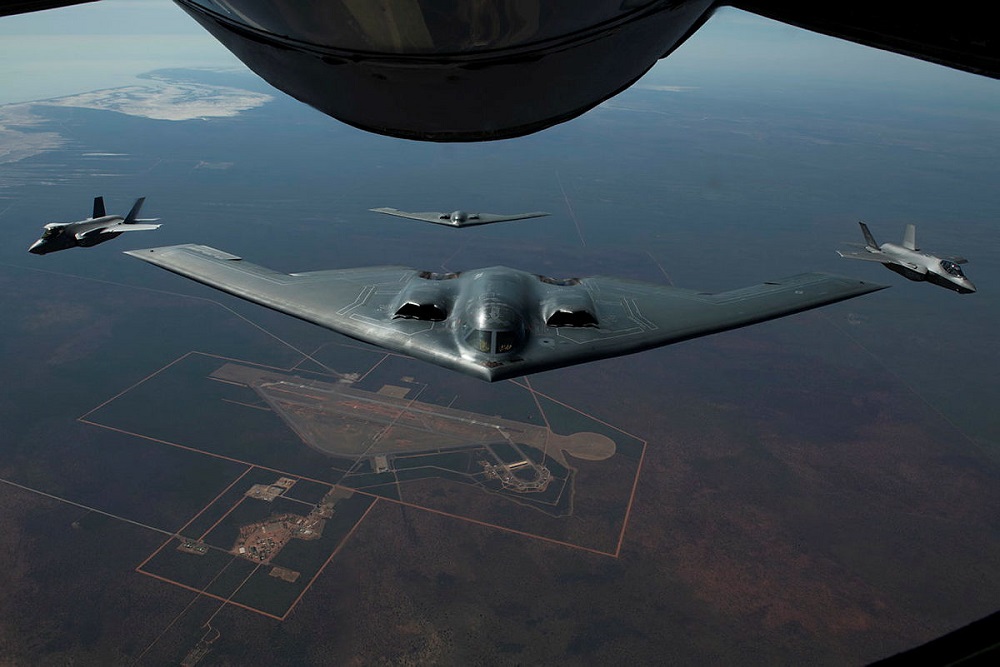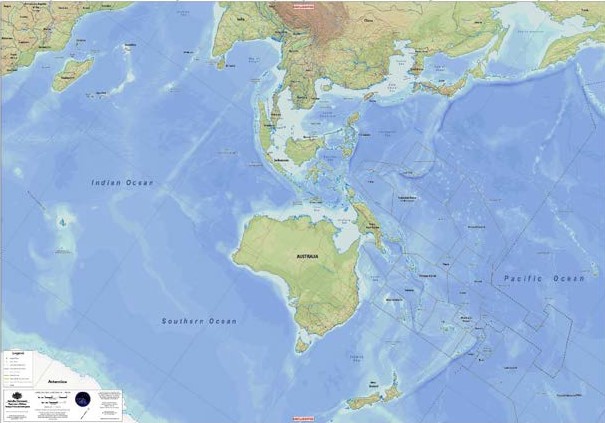
On page 27 of National defence, the report of the defence strategic review, is a map of Australia’s strategic geography. It superbly situates us and perfectly explains why a power in the distant reaches of the Indo-Pacific wanting to play a major role would consider Australia to be critical. Australia points straight into the archipelago that connects the Indian and Pacific oceans. Our land mass is immense, even alongside Asia. It suggests that Australia is a potent piece of real estate and a valuable US ally. It suggests other things as well.

Source: Australian government, National defence: defence strategic review, page 27.
Influential in my time as defence minister was a Royal Australian Air Force planning map focused on Darwin with semicircles spreading north, deep into our area of direct military interest. In essence, that ‘defence of Australia’ map underpinned a defence-in-depth strategy. When he departed my office, Hugh White took it (with my permission) and he used it well in his subsequent defence career.
The new map reorients us, turning the continent on its side and making Western Australia the front line for us and our ally. Our past geographic perspective had southeastern and southwestern Australia, our population centre and our defence depth a long way from harm’s way. On the new map, the southeast is our defence in depth. The west is where we and our ally project.
In the 1987 defence white paper (pages 100 and 101) there are two graphs. The first deals with the percentage of GDP devoted to defence between 1964 and 1986. The second shows the percentage of the budget allocated to defence over the same period compared with education, health and social security. A peak of 4.5% of GDP was spent on defence during the Vietnam War—about the same as was spent on social security—and that was down to a little below 3% by 1987. By 1987, defence had 10% of the budget, just pipped by health, but ahead of education, and it was dwarfed by social security at close to 30%. Now defence has about 6% of the budget.
This tale is integral to our dependence on the US. In the 2023–24 budget, defence received more than $50 billion for the first time. That’s just above 2% of GDP—what the US encourages allies to spend. When I was Australia’s ambassador to the US in the 2010s, that was constantly raised with me. Apart from Britain and France, NATO allies fall below 2%. The 2023–24 budget shows how difficult it is to keep a focus on defence. Overwhelmingly, the government prioritised cost-of-living relief, wages for aged care workers, and increases in the National Disability Insurance Scheme and for those on unemployment benefits. Increasingly louder than defence are the states, many of which are facing financial challenges.
With only minor increases in defence outlays over the four years of the forward estimates, anything essential will have to be funded by savings elsewhere in the portfolio. This means that the ambitious review is likely to see ambition constrained for some time. Given an absence of more resources, Australia’s defence function will remain heavily dependent on the US.
The 1987 defence white paper stated:
This Government’s policy of defence self-reliance gives priority to the ability to defend ourselves with our own resources. Australia must have the military capability to prevent an enemy from attacking us successfully in our sea and air approaches, gaining a foothold on our territory, or extracting political concessions from us through the use of military force. These are uniquely Australian interests and Australia must have the independent military capability to defend them.
The US alliance has provided us with excellent intelligence, training and access to essential weapons. Also, ANZUS hovering in the background was a further deterrent to any local power contemplating interference with Australia. As the 1987 white paper put it: ‘These arrangements emphasise Australia’s membership of the Western strategic community, and they enhance regional stability. The interests of Australia’s allies and regional associates are advanced by Australia’s ability to provide for its own defence.’
Australia wouldn’t be a drag on the Americans because our region was a strategic backwater for them. And we would help keep it that way. We understood that the joint facilities in Australia were critical to the US in the global strategic balance. The white paper indicated that in a global conflagration, these facilities would be nuclear targets. At the time, we negotiated Australian participation in all the joint facilities.
Particularly in intelligence and early warning, they were very useful to us directly and could be included in our order of battle. Uniquely among US allies, nothing that threatened Australia was likely to force the US to contemplate its own devastation if it came to our aid. Other allies effectively absorbed American security. In our case, the advantage lay with the US, and we wanted the US to comprehend that. The US provided useful diplomatic and military cover for our involvement in the East Timor crisis without Washington paying a heavy price.
All that is changed now. Australia no longer in a strategic backwater. China’s emergence as a military power and the South China Sea being contested paint a very different picture. Our redefined area of military interest incorporates that zone. We see it as vital.
China’s rise has completely changed the concept of warning time and it’s of no value in calculating the emergence of a major threat to our interests and approaches. That can be mounted now from capabilities within the region.
As the strategic review notes, our long engagement in the Middle East has frayed the force structure that was essential for the old defence of Australia. As we transition to the notion of national defence, an enhanced and expanded alliance with the US, including key force posture initiatives in Australia, is seen as a top priority. The US is no longer the unipolar leader of the Indo-Pacific and the region is now the centre of intense major-power strategic competition.
The 1987’s layered approach to defending the continent has shifted to deterrence and denial at distance from Australia. ‘As most of these objectives [for our strategic posture] lie well beyond our borders,’ the review says, ‘the ADF must have the capacity to engage in impactful projection across the full spectrum of proportionate response. The ADF must be able to hold an adversary at risk further from our shores.’
This requires a heavy emphasis on long-range precision-guided missiles in all three services, including on nuclear-powered submarines (SSNs), which are long in the future. In the meantime comes infrastructure for the rotation of US and UK submarines through HMAS Stirling, then acquisition of US submarines before the arrival of Australian- and British-made SSNs almost two decades from now.
The budget makes a start on all this by allocating $1.2 billion, or 15% of the overall new equipment budget, for US precision munitions. Likewise, there’s a commitment to making our northern bases—Scherger, Tindal, Curtin, Learmonth and Cocos Islands—fit for warfighting.
Most of the equipment requires substantial resources and, absent that, time. Much in the review depends on our ally’s support for the new capabilities and its open presence.
Given that the government and the Australian people demand resources for other purposes, it’s difficult to dramatically fund the increased capabilities we need to get the Americans here. They have indicated clearly their willingness to help develop our northern bases. We should prioritise them, along with facilities for SSNs at HMAS Stirling.
The urgency of our times is such that if anything does go wrong, the US military’s ability to use properly hardened and logistically prepared bases is critical for deterrence now.
As the map shows, the Americans can see that Australian geography advantages them. From a hitherto intense east–west perspective on the Indo-Pacific, they are rapidly absorbing for themselves the longstanding Australian north–south perspective in addition. They find themselves in support of their best placed ally in the region.
The budget demonstrates that we can’t resource a massively expanded ADF now, an uncomfortable position that’s a product of decades of under-resourcing and misdirection. Our ally, like ourselves, is desperate for deterrence to succeed. It doesn’t want war, but it has much more to deter than we have.
Our view of the capacity of the US is constantly caught up in the cacophony of its domestic politics and foreign policy errors, leading some of our commentators to constantly question American ability. That misses the underlying capacity of the US military, the inventiveness of its research community and its massive resources. We are deeply embedded in US military, national security agencies and weapons acquisition programs. They have a resilience that the day-to-day politics might not reflect. It’s important that they’re prepared to engage in our region. We have nothing else to rely on.
Moving away from the US as uncertainties mount in our region accrue would be extraordinarily risky. If other powers in the region decide that access to our resources or land would solve their problems, we wouldn’t have the means to handle it.
If a gutted US does emerge, prepare for a defence outlay massively north of 2% of GDP.

